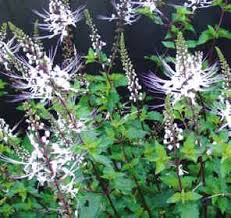MISAI KUCHING -Orthosiphon Stamineus
Dear Friends! Do not be afraid of kidney problems.?
CONSULT WITH YOUR PHYSICIANS BEFORE IT IS TOO LATE!
Go for second option.
 Cat Whiskers
Cat Whiskers
Orthosiphon stamineus is a herb that is widely grown in tropical areas. It is also known as Orthosiphon aristatus. The plant can be identified by its white or purple flowers bearing long, protruding stamens that resemble cats' whiskers. It is also commonly referred as "Misai Kucing" (Malaysian) or "Kumis Kucing"(Indonesian) which means cat whiskers. The herb is popularly known as Java tea and is used widely in the form of herbal tea in Asia.Java tea was possibly introduced to the West in the early 20th century. The brewing of Java tea is similar to that for other teas. It is soaked in hot boiling water for about three minutes, and honey or milk is then added. It can be easily prepared as garden tea from the dried leaves. There are quite a number of commercial products derived from Orthosiphon stamineus. Cultivation areas and post-harvesting method can significantly affect the quality of the herb.
It is a tea made solely from the misai kucing herb which has been known for its therapeutic value for generations.
Misai Kuching Tea comes in sachets packed commercially with the catch phrase “taste the freshness”, thanks to Melaka Biotechnology Corporation’s efforts in exploiting the therapeutic value of misai kucing.
Helps in managing high blood sugar level
 Siddha Medicinal Uses :For Kidney stones leaves or whole plant is taken, prepared as decoction and taken daily once.Decoction of leaves acts as diuretic. Drinking 30 ml of this decoction helps in managing disurea and urinary tract infections.
Siddha Medicinal Uses :For Kidney stones leaves or whole plant is taken, prepared as decoction and taken daily once.Decoction of leaves acts as diuretic. Drinking 30 ml of this decoction helps in managing disurea and urinary tract infections.
Leaf juice 5 to 10 ml thrice a day helps in managing high sugar level.
Infusion made of dried leaves are good for gallbladder stones and liver ailments.
This diuretic effect helps with gout, kidney stones and high blood pressure.
physicianpackiam
http://www.sidhhaherbs.blogspot.com
http://www.sidhhaherbs.blogspot.com

